Top ten battles of the Civil War… Just for fun…
August 14, 2013 by GuyHeilenman · 1 Comment
 A common way to collect historic newspapers is to assemble reports regarding various “top ten” lists. In the past, we have explored several such lists:
A common way to collect historic newspapers is to assemble reports regarding various “top ten” lists. In the past, we have explored several such lists:
When it comes to the Civil War (one of the most popular targets within the collectible community), “top tens” can take on various forms: Top ten noteworthy Generals, top ten most impacting events, top ten naval battles, top ten events/causes for the war, etc. In this vein, shown below are various links focused on top ten battles. Which were the most important? Opinions certainly will vary… which is why no two collections are the same. As an added bonus, how about exploring the top ten “under the radar” battles which do not typically make a top ten list? We’d love to have input.
Top 10 Battles of the Civil War – by Charles Gromley on Prezi
The Ten Costliest Battles of the Civil War
Top 10 Civil War Sites
Ten Bloodiest Civil War Battles
Top ten battles in civil war – WikiAnswers
Civil War Top 10 Lists
Decorative newspapers on Pinterest…
August 9, 2013 by GuyHeilenman · Leave a Comment
 When most think of newspapers, while flashy headlines and occasional dramatic images may come to mind, for the most part small black text on pale newsprint is what is imagined. However, there was a time when the images printed within newspapers verged on the cusp of being considered art. Woodcuts prints of the mid-19th century and the early color images are still highly sought after for framing. While the former typically receive all of the attention, we’ve recently put together a Pinterest board showing a number of wonderful prints which appeared in newspapers from 1850-1875. Please enjoy: Decorative Prints [1850-1875]
When most think of newspapers, while flashy headlines and occasional dramatic images may come to mind, for the most part small black text on pale newsprint is what is imagined. However, there was a time when the images printed within newspapers verged on the cusp of being considered art. Woodcuts prints of the mid-19th century and the early color images are still highly sought after for framing. While the former typically receive all of the attention, we’ve recently put together a Pinterest board showing a number of wonderful prints which appeared in newspapers from 1850-1875. Please enjoy: Decorative Prints [1850-1875]
Some back-handed compliments for Abe Lincoln…
August 2, 2013 by TimHughes · Leave a Comment
The June 5, 1860 issue of the “New York Tribune” has two testimonials as to the character of Abraham Lincoln, to be the Republican nomination for President in the up-coming election. The second report is by the Honorable George Ashmun and offers some interesting comments. Also, “The Daily Delta” from New Orleans, issue of Feb. 27, 1861 has an equally back-handed “compliment” on the appearance of Lincoln (see below), noting he: “…is not handsome by a great many degrees,but he has not that hideous, ugly look which his portraits give him…”: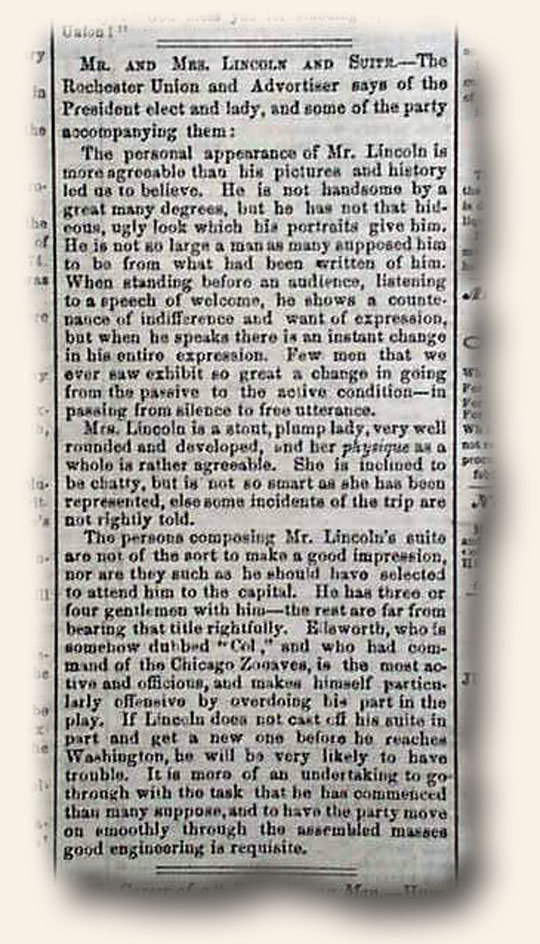
The editor shows his bias…
July 26, 2013 by TimHughes · Leave a Comment
Editorials from the 19th century were often quite frank and not afraid to mince words, and perhaps the most scathing comments were found in newspapers during the Civil War years. The “Daily Examiner” newspaper from Richmond, Virginia, January 20, 1865, has an editorial which begins with some very biased words about Andrew Johnson: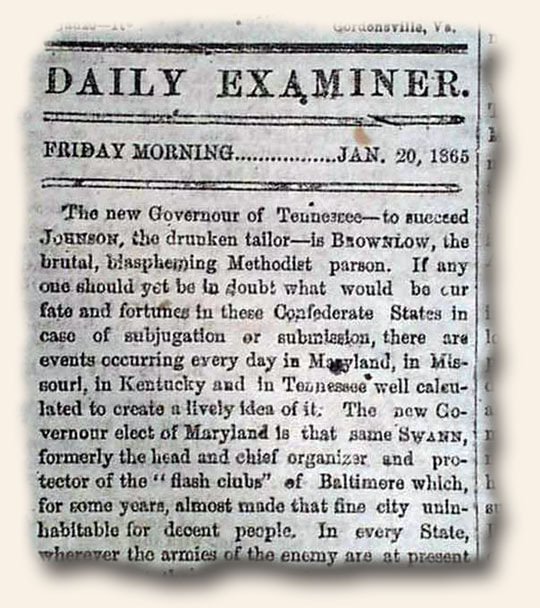
Documenting an early reprint of the Ulster County Gazette…
July 22, 2013 by TimHughes · 3 Comments
If the “infamous” “New York Herald” issue of April 15, 1865 is the most common reprint edition about which we receive phone calls and messages, then the “Ulster County Gazette” of January 4, 1800 has to be next in line.
The front page of a curious little periodical titled “Type of the Times” from Cincinnati, March 15, 1858, provides solid evidence of just how early the “Ulster County Gazette” was reprinted. I had known there were many editions as I’ve seen a multitude of variant issues on different qualities of newsprint–some on rag paper–but this is the first hard evidence of just how early at least one of the reprints was created: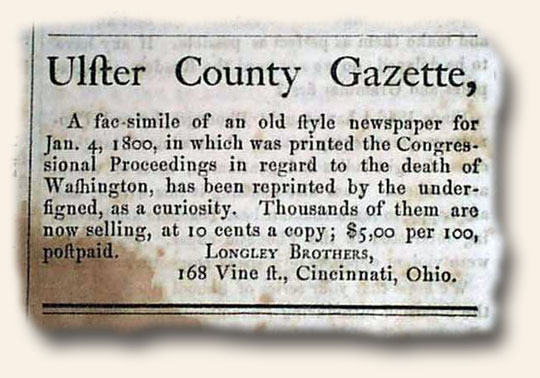
The Traveler… Texas declares independence… Fort Miegs…
July 15, 2013 by The Traveler · Leave a Comment
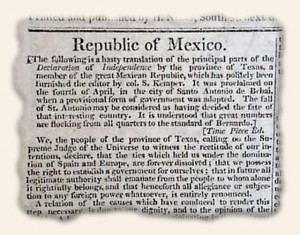 Today my journeys took me to Baltimore, Maryland, by the means of The Weekly Register dated July 17, 1813. The front page features the headline “Republic of Mexico” which was announcing the Declaration of Independence of Texas. “We, the people of the province of Texas,…declare, that the ties which held us under the domination of Spain and Europe, are forever dissolved; that we possess the right to establish a government for ourselves; that in future all legitimate authority shall emanate from the people to whom alone it rightfully belongs and that henceforth all allegiance or subjection to any foreign power whatsoever, is entirely renounced… We feel, with indignation, the unheard of tyranny of being excluded from all communication with other nations, which might tend to improve our situation, physical and moral, We were prohibited the use of books, of speech, and even of thought — our country was our prison… We conceive it a duty we owe as well to ourselves as to our posterity, to seize the moment which now offers itself, of shaking off the yoke of European domination, and of laboring in the cause of the independence of Mexico; taking the authority into our own hands, forming laws, and of placing the government of our country upon a sure and firm basis, and by the means assume a rank among the nations of the world.”
Today my journeys took me to Baltimore, Maryland, by the means of The Weekly Register dated July 17, 1813. The front page features the headline “Republic of Mexico” which was announcing the Declaration of Independence of Texas. “We, the people of the province of Texas,…declare, that the ties which held us under the domination of Spain and Europe, are forever dissolved; that we possess the right to establish a government for ourselves; that in future all legitimate authority shall emanate from the people to whom alone it rightfully belongs and that henceforth all allegiance or subjection to any foreign power whatsoever, is entirely renounced… We feel, with indignation, the unheard of tyranny of being excluded from all communication with other nations, which might tend to improve our situation, physical and moral, We were prohibited the use of books, of speech, and even of thought — our country was our prison… We conceive it a duty we owe as well to ourselves as to our posterity, to seize the moment which now offers itself, of shaking off the yoke of European domination, and of laboring in the cause of the independence of Mexico; taking the authority into our own hands, forming laws, and of placing the government of our country upon a sure and firm basis, and by the means assume a rank among the nations of the world.”
Also within the issue is a full page map (which are rarely found in this title): “Map of the Rapids of Miami, Shewing the situation of Fort Meigs, etc”, accompanied by supporting text: “Interesting Topography of Ohio”.
~The Traveler
Must have been a terrifying funeral…
June 24, 2013 by TimHughes · Leave a Comment
The “Richmond Enquirer” newspaper from Virginia, issue of December 8, 1821, included this very interesting article titled: “Resurrection From The Grave”. While the inking makes it a bit difficult to read, please… enjoy?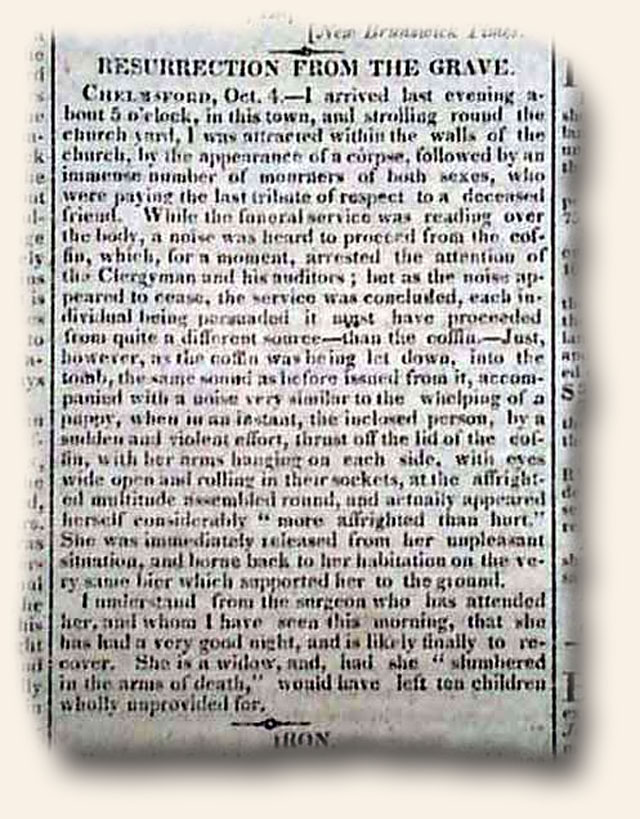
Niles’ Weekly Register documented the first half of the 19th century…
June 14, 2013 by TimHughes · 2 Comments
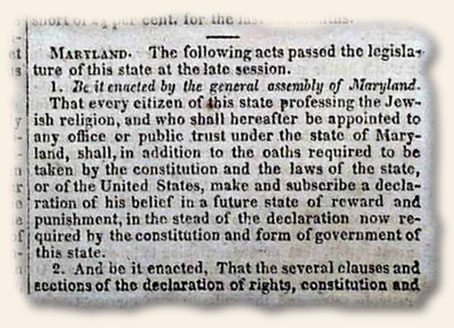 Of the many notable newspapers published in the history of the United States there are a few stand-outs for different eras. Of the colonial era the “Pennsylvania Gazette” came to prominence under the guidance of publisher Ben Franklin, and in the latter decades of the 1700’s the “Gazette of the United States“, and the “Columbian Centinel” were two of the more significant titles which informed the American populace for many years. Of the 19th century the “National Intelligencer” and the “New York Times” were certainly among the more prominent, but a title which did as much as any other to bring the news into the households of America was “Niles’ Weekly Register“.
Of the many notable newspapers published in the history of the United States there are a few stand-outs for different eras. Of the colonial era the “Pennsylvania Gazette” came to prominence under the guidance of publisher Ben Franklin, and in the latter decades of the 1700’s the “Gazette of the United States“, and the “Columbian Centinel” were two of the more significant titles which informed the American populace for many years. Of the 19th century the “National Intelligencer” and the “New York Times” were certainly among the more prominent, but a title which did as much as any other to bring the news into the households of America was “Niles’ Weekly Register“.
Considered by some a magazine due to its small size, I like to consider it a small newspaper, as its content was more aligned to presenting the politics & other news of the day rather than the literary content more associated with magazines. But of curious note is that it was devoid of advertising, relying entirely upon the strength of its subscription base for its existence.
Hezekiah Niles edited and published his newspaper in Baltimore from 1811 until 1836, making it into one of the most widely-circulated periodicals in the United States and himself into one of the most influential journalists of his day. Devoted primarily to politics, “Niles’ Weekly Register” is considered an important source for the history of the period. It continued beyond his demise until 1849.
Given its close proximity to the nation’s capital it was in an excellent position to print political reports but also the wealth of other news from all corners of the then-growing country which would eventually find its way to Washington, D.C. Having collected early newspapers for over 37 years I can attest to the quality of reporting–very in depth–in comparison to the physically larger newspapers of the day.
Founded just a year before the outbreak of the War of 1812 and lasting through the early period of the California Gold Rush, a great wealth of American history was printed within each of its 16 weekly pages, and a nice spectrum of America in the first half of the 19th century can be gathered by simply focusing on this one title.
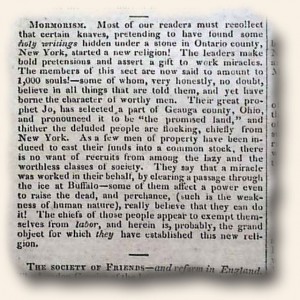 Early in its publication the battle of Tippecanoe brought the name William Henry Harrison to prominence with his victory over the Indians, the details of which made the pages of “Niles’ Weekly Register“. Then all the event of the War of 1812, from President Monroe’s war proclamation to the war-ending Battle of New Orleans led by Andrew Jackson (actually fought after the treaty ending the war was signed) with the host of naval battles of 1812-1815.
Early in its publication the battle of Tippecanoe brought the name William Henry Harrison to prominence with his victory over the Indians, the details of which made the pages of “Niles’ Weekly Register“. Then all the event of the War of 1812, from President Monroe’s war proclamation to the war-ending Battle of New Orleans led by Andrew Jackson (actually fought after the treaty ending the war was signed) with the host of naval battles of 1812-1815.
There is hardly a topic or event from American history not found in Niles’ Weekly Register. Much Judaica content, the creation of the Mormon Church and their journey west, much on the historic Maryland Jew Bill, and even mention of Abraham Lincoln and Robert E. Lee long before they would be names known to the American public were found in this newspaper.
The slavery issue was certainly not side-stepped, as reports on Nat Turner’s Rebellion and the Denmark Vesey case were two of the more notably events which received much coverage. The Amistad affair–not found in every newspaper of the day–was reported in many issues of Niles’ as the events & trial unfolded. Certainly the issue is slavery was ever-present in congressional reports, and was a factor in the Missouri Compromise, also published in this newspaper.
As the country continued to expand, the westward march was documented in many reports including the development & opening of the Erie Canal, the exploring of the Yellowstone region, and the creation of the Santa Fe Trail being just a few. Several states joined the union during the years of Niles’ and as they did even the alterations to the United States flag were documented by the newspaper. Names such as Daniel Boone, infamous pirate Jean LaFitte, Samuel Morse, Daguerre and Eli Whitney are a few which were featured as their actions and inventions made news.
The Texas war for independence made the news in 1835 and 1836 and many of the notable battles were reported. There is even mention of Davy Crockett leaving Congress and heading to Texas to fight for their cause, where he would meet his end at the famous Battle of the Alamo.
With politics as a focus it is no surprise that elections and inaugurations were all documents in “Niles’ Weekly Register“, including the short term of President William Henry Harrison who just one month after being inaugurated would die in office.
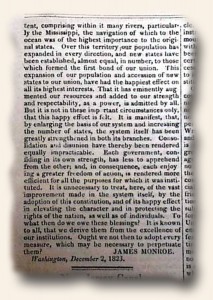 There is so much more history to be found within the pages of Niles’. Our troubling (and often disgraceful) relationship with the Native American Indians, including the Black Hawk War & Trail of Tears, was covered in much detail. The Mexican War and all its events was the last of the military encounters to appear in this newspaper, the treaty ending that war being signed in 1848, just one year before the demise of the newspaper.
There is so much more history to be found within the pages of Niles’. Our troubling (and often disgraceful) relationship with the Native American Indians, including the Black Hawk War & Trail of Tears, was covered in much detail. The Mexican War and all its events was the last of the military encounters to appear in this newspaper, the treaty ending that war being signed in 1848, just one year before the demise of the newspaper.
The ironic same-day deaths of Presidents Thomas Jefferson and John Adams, and on the 50th anniversary of the Declaration of Independence, received much coverage; the Monroe Doctrine and the curious efforts of Mordecai Manuel Noah to create a Jewish settlement on an island in the Niagara River are just two of the fascinating events of American history documented. And it was not just American history that was reported, as world-wide events, as their significance would dictate, would make the pages of Niles’ as well, not the least of which was the historic battle of Waterloo which spelled the doom of Napoleon’s efforts in Europe.
It was a pint-sized newspaper with a powerful impact upon the documentation of American history in the first half of the 19th century. It is a title every collector should not overlook as they consider the best newspapers for reporting some of the major events in history. They all will be found in “Niles’ Weekly Register“.
The Traveler… deaths of General Pike and Major Stoddard… recruiting…
June 3, 2013 by The Traveler · Leave a Comment
Today I traveled to Hartford, Connecticut by the way of the American Mercury dated June 1, 1813. There I found an extract of letter from an officer to his father. He writes from Sacket’s Harbor pertaining to the Battle of York, “We arrived at this place last evening from Niagara. The body of General Pike was with us. He was killed by the explosion of a magazine, on which a vast collection of stones, shots, and other missiles were collected. I was wounded; but, thank God, not dangerously….”.
 Also reported in this issue is the Siege of Fort Miegs and the death of Major Stoddard. “…I am sorry to inform you that Major Stoddard died the night before I left the Rapids, of a lock-jaw, produced by a slight wound from a fragment of a shell which struck him on the thigh…”.
Also reported in this issue is the Siege of Fort Miegs and the death of Major Stoddard. “…I am sorry to inform you that Major Stoddard died the night before I left the Rapids, of a lock-jaw, produced by a slight wound from a fragment of a shell which struck him on the thigh…”.
The back page of the issue carries a “New Corps Enlisted For One Year!!!” advertisement. This contained a quote from an European political writer “…The Americans are active in their person: they are enterprising; they are brave; and, which is of vast consequence, they are, from education and almost from constitution, SOBER, a virtue not at all less valuable in the Army than it is in domestic life…”.
~The Traveler
The post-Civil War: an era rich in history…
May 27, 2013 by TimHughes · Leave a Comment
 Few eras of American history have been romanticized as the Post-Civil War 19th Century. For those who grew up in the 1950’s & 1960’s, television had more than its fair share of Western-themed shows. And the “Wild West” was a common feature on the silver screen as well.
Few eras of American history have been romanticized as the Post-Civil War 19th Century. For those who grew up in the 1950’s & 1960’s, television had more than its fair share of Western-themed shows. And the “Wild West” was a common feature on the silver screen as well.
Not only can one capture a flavor of that time when the American frontier was pushing further West, but actual historical events can be read as captured in newspapers of the day, when the events happened. This is the intrigue of collecting rare and historic newspapers.
From the moment the Civil War ended, the national focus was on the lands west of the Mississippi. It was common to find reports, even in newspapers from the big cities of the East, of skirmishes with Indians on the Great Plains and elsewhere. The Custer Massacre perhaps ranking as the most notable, but reports can be found on the Battle of Wounded Knee, Captain Jack and the Modoc Indian War, reports of Geronimo, Sitting Bull, the Apaches and others. Newspapers are a great resource for those wishing to explore/collect Native American history.
And what about Outlaws & Gunfights? Stage coach robbery reports are not an uncommonly found in newspapers from the 1870’s and 1880’s, and train robberies and bank robberies could be found scattered throughout newspapers of this period as well. It was a time when some of the more famous—and infamous–names of American history could be found in newspapers, including Jesse James and his gang, Billy the Kid, Wyatt Earp (yes, there are newspaper reports of the Gunfight at the O.K. Corral), the Dalton Gang, Younger brothers, Robert Ford, Buffalo Bill, Jim Bridger, Vasquez, Doc Holliday, Kit Carson, Lizzie Borden, and on and on. Although “Jack the Ripper” was a name from London crime history his deeds made headlines on this side of the Atlantic as well. Reports of their deeds are not fictionalized; they are the events as reported in newspaper accounts of the day.
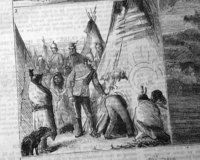 Some the famous towns of the Old West had their own newspapers and can be purchased for anyone’s collection, including titles from Tombstone, Leavenworth, Deadwood, Tucson, Reno, San Francisco, Leadville, Carson City, Denver, Salt Lake City, and many more.
Some the famous towns of the Old West had their own newspapers and can be purchased for anyone’s collection, including titles from Tombstone, Leavenworth, Deadwood, Tucson, Reno, San Francisco, Leadville, Carson City, Denver, Salt Lake City, and many more.
Although crime reports were common, there is so much more in newspapers from this era. Politics certainly found their way into newspapers on a daily basis. Ulysses S. Grant and James Garfield were perhaps the most notable Presidents of the era, and reports on the latter’s assassination are commonly found. Science and innovation were the focus of the famous title “Scientific American” which began in 1845 and still publishes today. Within its pages were many reports on Thomas Edison, Alexander Graham Bell and their inventive work, plus illustrations of the creations of many of the devices and improvements we still enjoy today. Many were first unveiled in Philadelphia’s Centennial Exposition of 1876 and the Columbian Exposition at Chicago in 1893.
It was a time when Brigham Young and the Mormons were venturing west, ultimately to settle in the Salt Lake City Valley. P.T. Barnum was making news with his circus, and Frederick Douglass & Booker T. Washington were coming to national prominence as spokesmen for the newly emancipated slaves. The Chicago Fire & the Johnstown Flood were but two disasters which changed the American landscape and graphic accounts were more brutal in the 19th century then they are today. 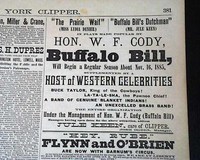 As is the case with present-day newspapers, sporting reports were typically found, with baseball, football, tennis and golf gaining widespread popularity as diversions for not just the wealthy but for everyone.
As is the case with present-day newspapers, sporting reports were typically found, with baseball, football, tennis and golf gaining widespread popularity as diversions for not just the wealthy but for everyone.
As you see the post-Civil War era was very rich in history. And I only touched on a few of the highlights. Newspapers of the era reported not just the events & names we know of through history books, but captured the mundane events of daily existence which provide a fascinating flavor of life in America when the wealth & prestige of the United States was emerging upon the world landscape. A world awaits the collector who delves into this fascinating era of American history.


